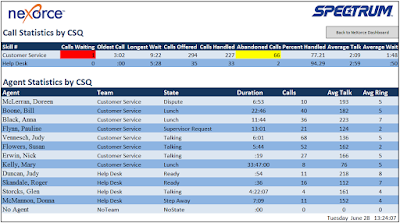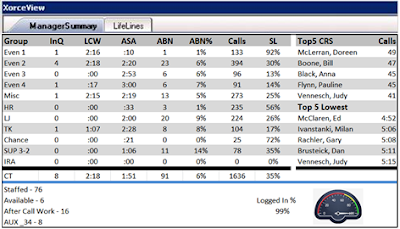Searching
for a Dashboard March
2016
Almost every contact center
software application now has a dashboard option available to you. So the question is why you need another
dashboard. Why are managers and senior management looking for dashboards when
they already have them at their fingertips?
Here are the top five reasons why:
1. Consolidation
of data from multiple applications; (platforms, internal data, other CC apps)
2. Drill
down capabilities to see the details; (from summary to group to agent detail)
3. Dynamic
Dashboard to meet your needs; (Out of the box, one size fits all)
4. Visual
appearance of critical metrics; (Grids vs graphics, data in the right place,
delete certain data)
5. Easy
to implement, use, and make changes.
Consolidation of Data
Consolidating data from multiple
sources is the most important feature of any dashboard. The benefit to you is your time and outcome
from seeing collaborated data cause and effect to your call center.
Dashboards that come with your contact
center platform do not allow for consolidation of the data. The data in the
dashboard is restricted to the ACD that you have in place today. The ability to combine data from other
sources is not allowed. There is a
realistic reason for this restriction; combining data from outside sources will
overload the server processor for the ACD causing it to shut down.
Today’s contact center has agents
taking calls, answering emails and having chat sessions with customers. The agent performance is no longer limited to
calls. As a manager you need to see
performance across multiple platforms.
However, you do not have the time to look at three dashboards to see the
status and performance of the agents. Also looking at one report does not give
you the combined performance metrics you need.
There is other data that may need
to be combined in your dashboard.
Information from WFM, IVR, CRM, Call Accounting or your outbound dialer
data may need to be added to you dashboard.
Your selection of the critical KPI’s should all be on the dashboard so
at a glimpse you are aware of the call center status and performance.
Senior management requires a
dashboard as well but with a different level of data. These dashboards combine internal financial
data to the overall contact center metrics.
The drill down to business level specifics is also needed but not
available from a single source dashboard.
Drill Down
The manager dashboard needs to have
multiple layers of content. The primary
page is summary information. It might
start with group level information from multiple data sources and then have
tabs that can be clicked on that goes into more detail such as specific group
with agent information. Every call
center is different and manager goals are unique. So the dashboard content should meet the
manager needs and requirements.
For example, start the summary main
page with overall contact center numbers.
It might have voice, email, chat and ticketing system data. The second tab could have specific group data
for voice showing all of the agent performance.
The third tab could be a combination of email and chat data per agent
for each group. The dashboard can be set
to meet your needs and show you contact performance by the agents. If your dashboard cannot combine this data
you will be required to open three dashboards just to see the overall
performance by group for voice, email and chat.
This is a tremendous time consumer.
As a manager you decide what data
is critical to you and integrate that data into your dashboard. If you are unable to combine and collaborate
data you should begin looking for a new dashboard.
Dynamic Dashboard
A dynamic dashboard is one that
will allow you to decide what your dashboard content will be and not restricted
to the application or platform that you utilize today. A dynamic dashboard allows you to:
·
Collect different data from multiple sources;
·
Allows you to move the data around in the
dashboard. Rows and columns of data do not remain fixed;
·
Data formulas are not restricted. The formulas can change as needed.
·
Data in the dashboard is based on your
login. A different manager login will
have different content.
An out-of-the-box, one size fits
all type dashboard does not allow you to combine data, make fundamental changes
to the dashboard layout, is static in design and content collaboration.
Visual Appearance
What is more important to you how
good it looks or having all of the content on the dashboard that you need? Your dashboard needs to meet your needs and
should be able to do what you require.
Maybe your dashboard has very little data and the critical content is in
graphs and charts. Or maybe your
dashboard has a lot of data and space would be wasted having charts take up
real estate. The decision really needs
to be yours and not the out-of-the-box application.
A text filled dashboard with agent
specific data.
A general overview dashboard for
senior management, combines data from multiple sources but does not go down
into details that the contact center manager might need. Secondary tabs would allow management to see
financial details.
Easy Implementation
The dashboard needs to be something
that is easy to implement and utilize.
However, caution is needed here because something that is too easy may
not give you the features and benefits that you are looking for in a dashboard.
When looking at dashboards be sure
to see how:
·
They are installed;
·
Data is selected for the report;
·
Changes can be made to the dashboard layout, if
using graphs and charts;
·
Messages are created and who they can be sent
to;
·
Remote access can be provided.
When searching for dashboards do
not be afraid to go outside of your ACD provider. Finding a product that allows for data
collaboration and drill down capabilities will help save time and improve
manager and senior management performance.
Never be satisfied with a dashboard that has restrictions that do not
allow you to see the data you need to see on a single report.
Spectrum is a leading
provider of Unified Contact Center Reporting. Contact Spectrum today to
discuss best practices for call center dashboards. For more examples of reporting visit our
website and the products page. http://www.specorp.com/products
















